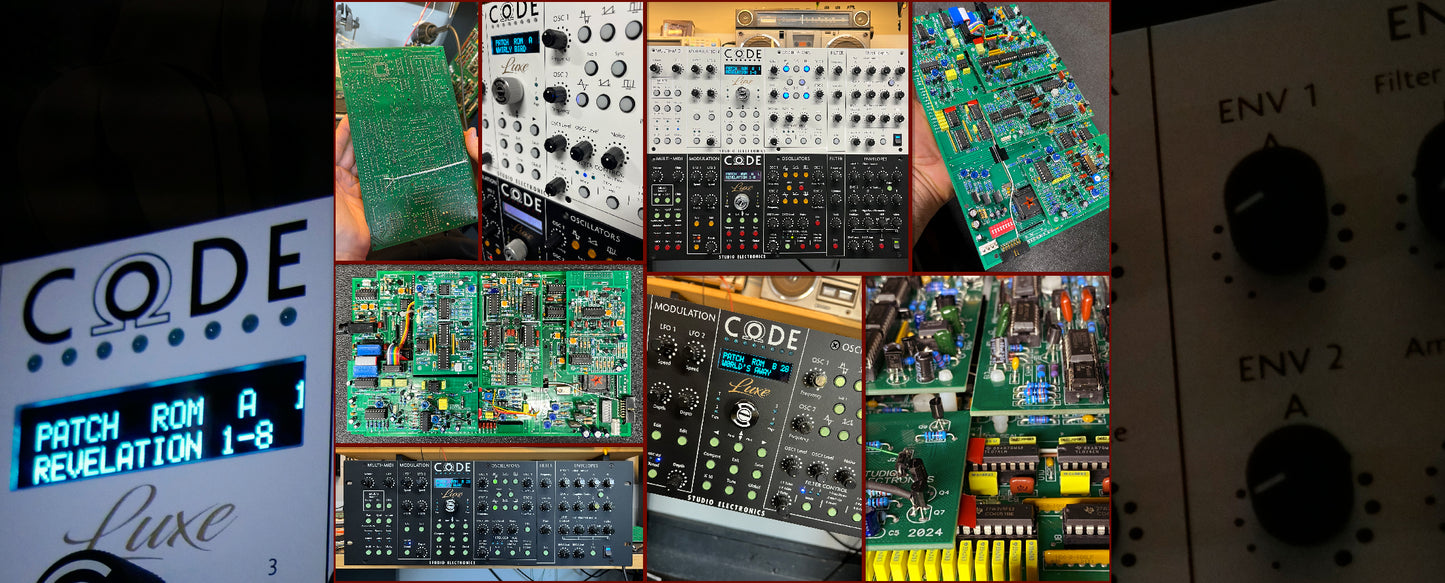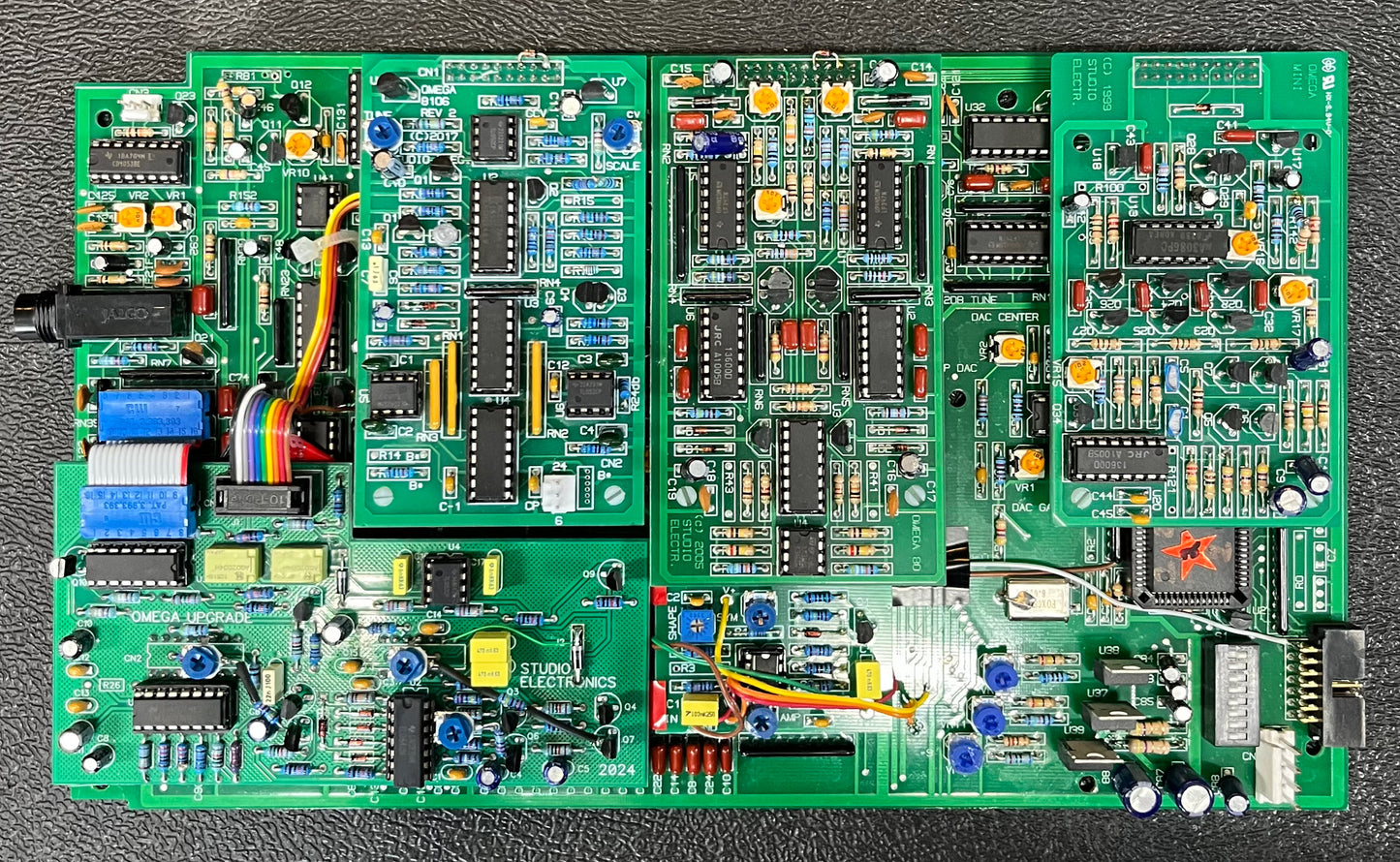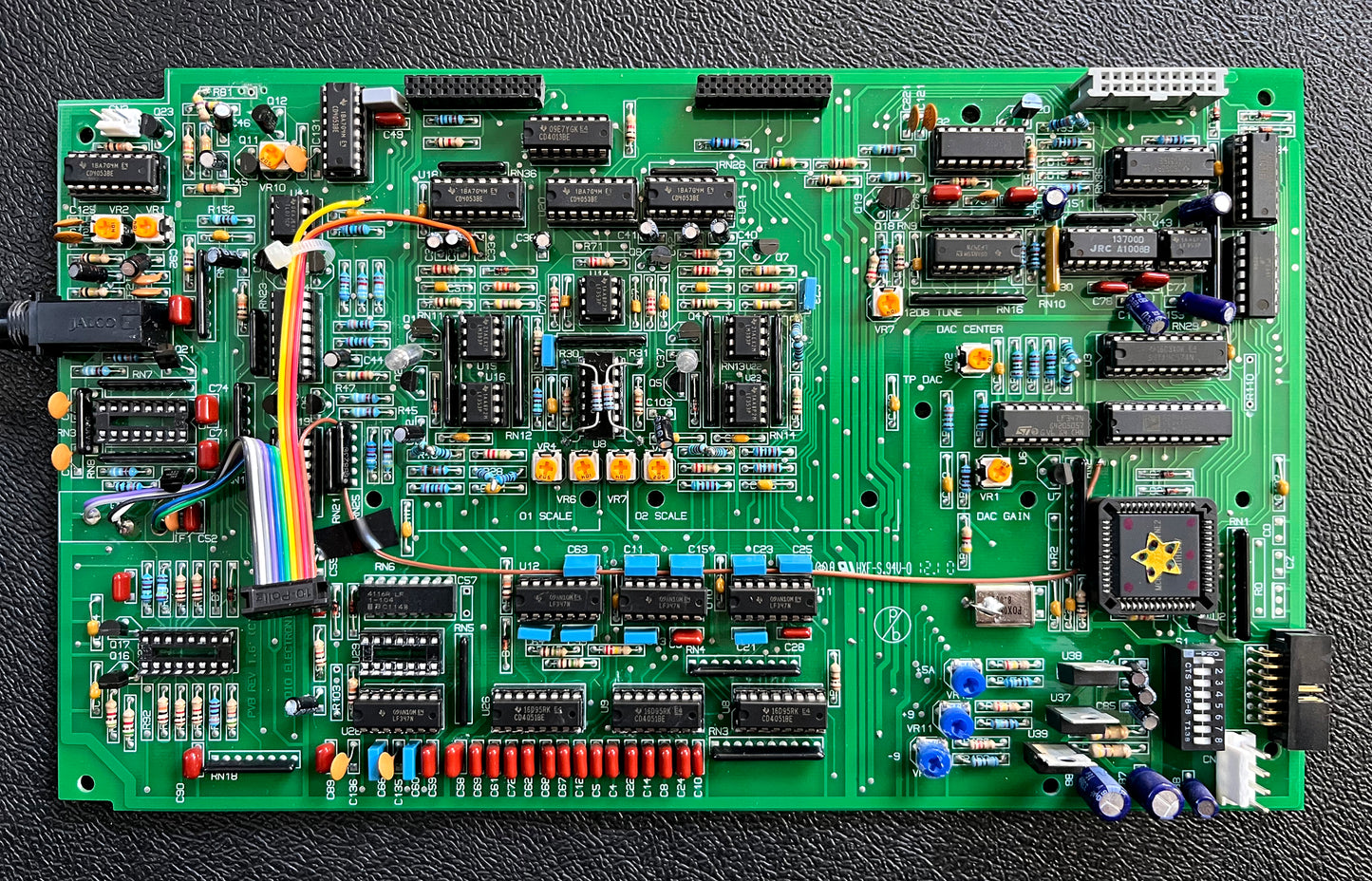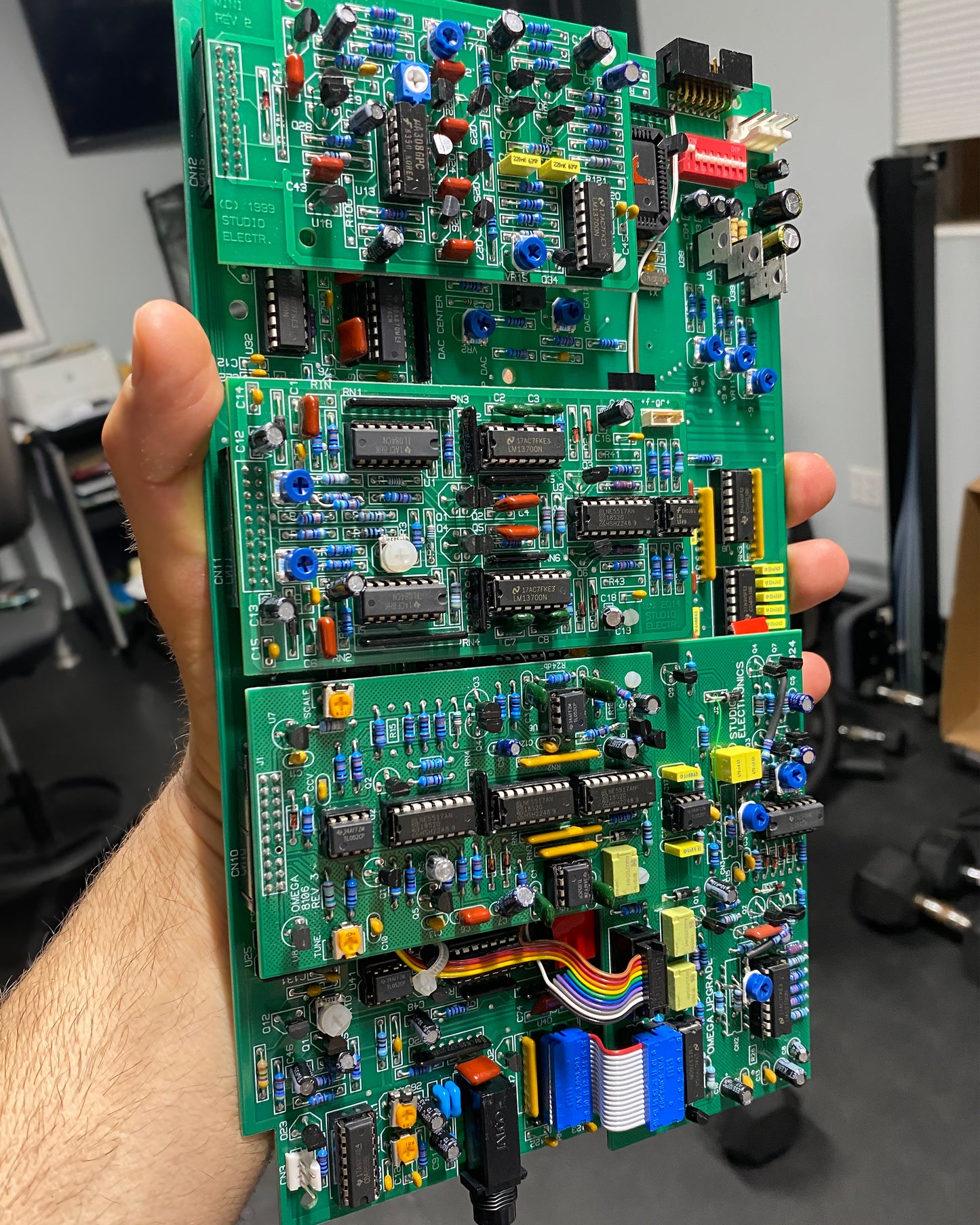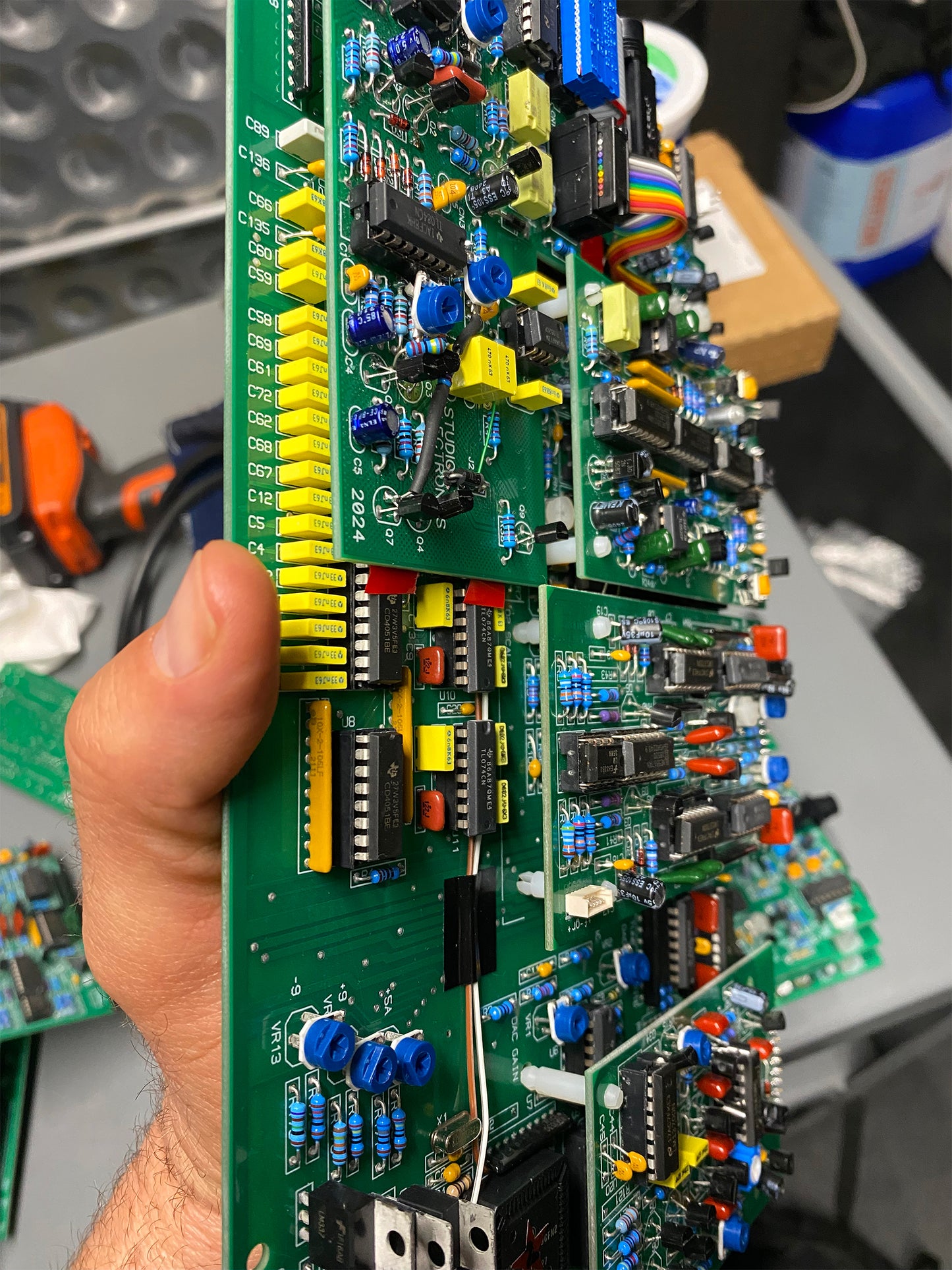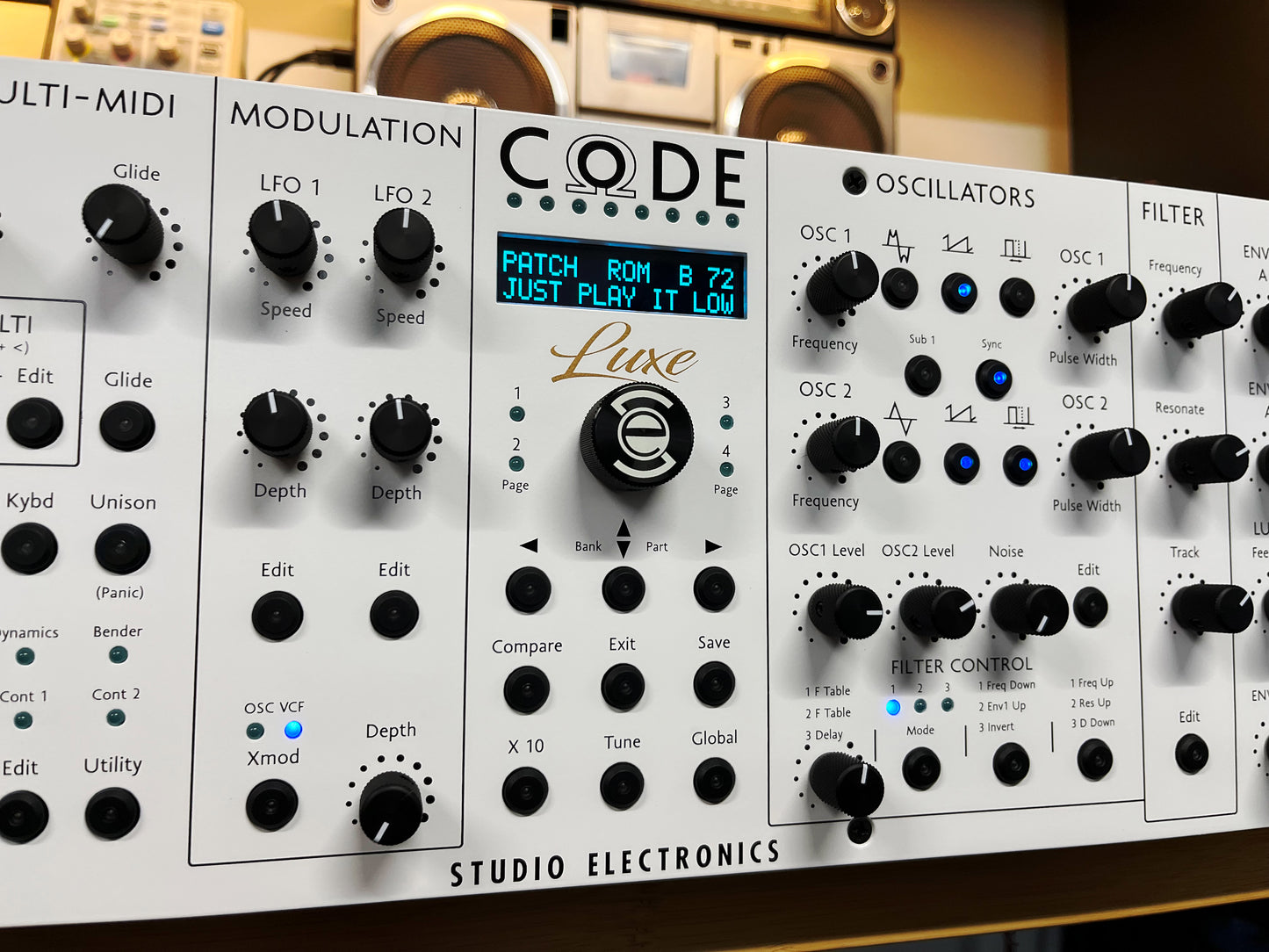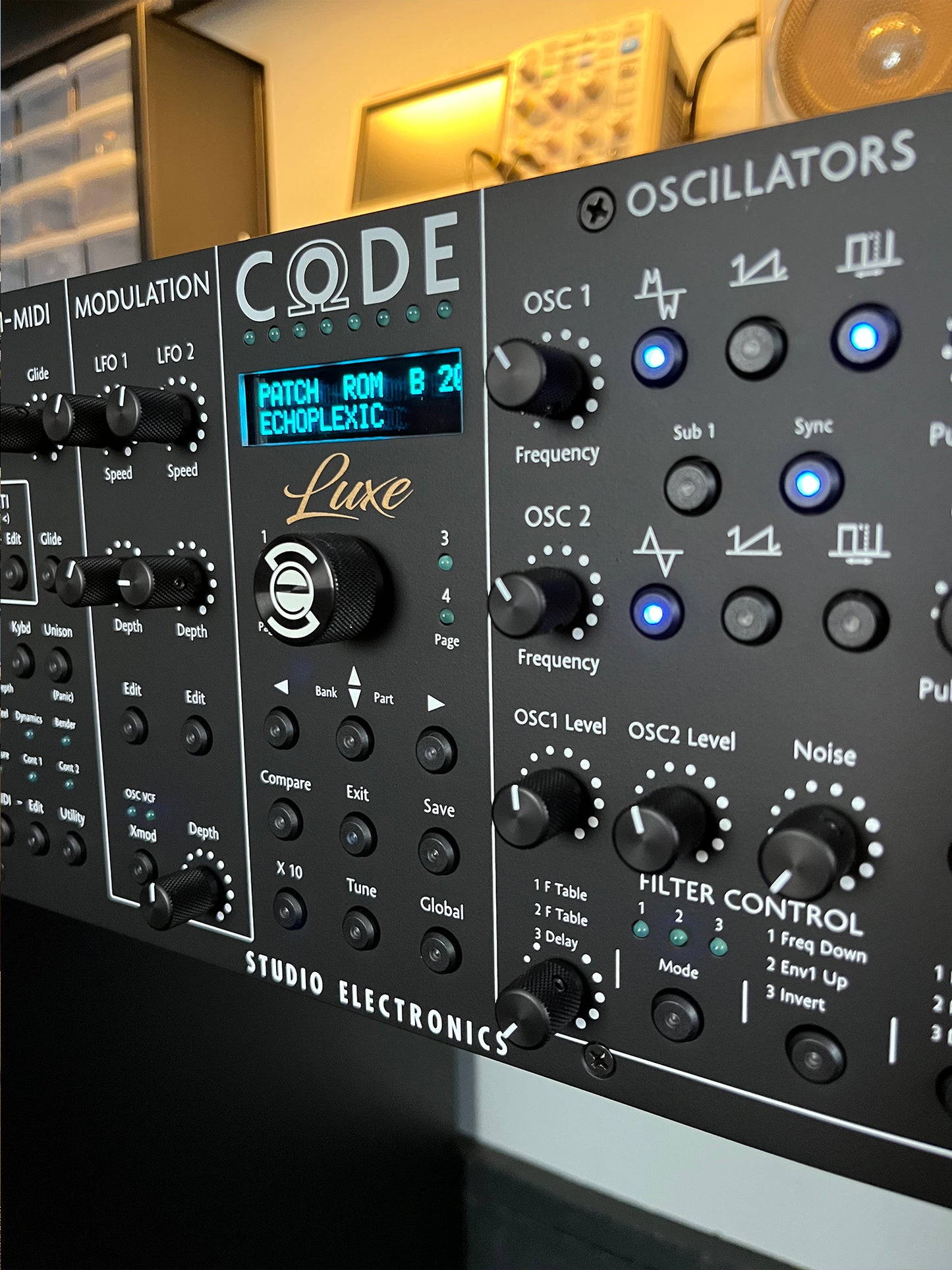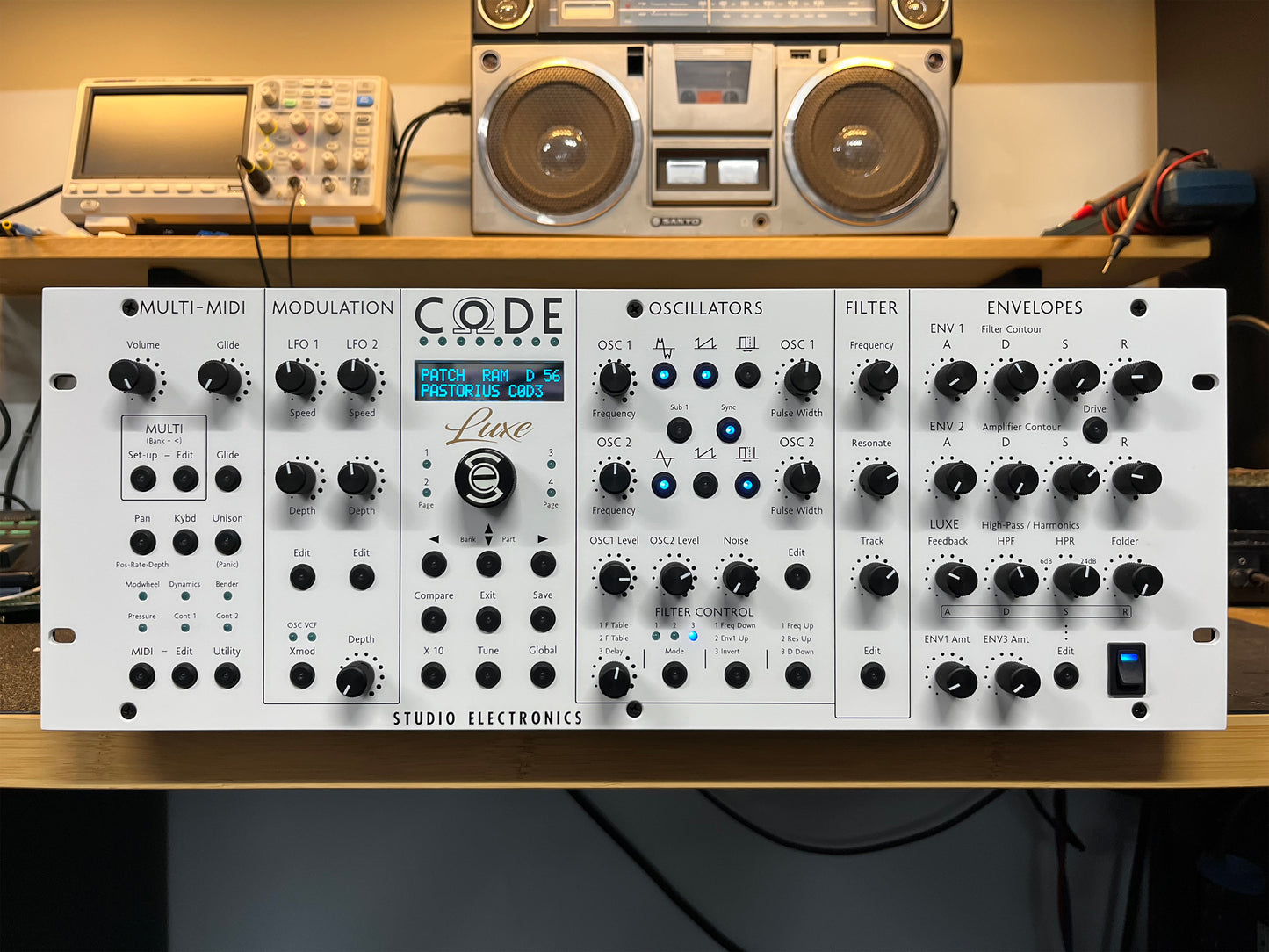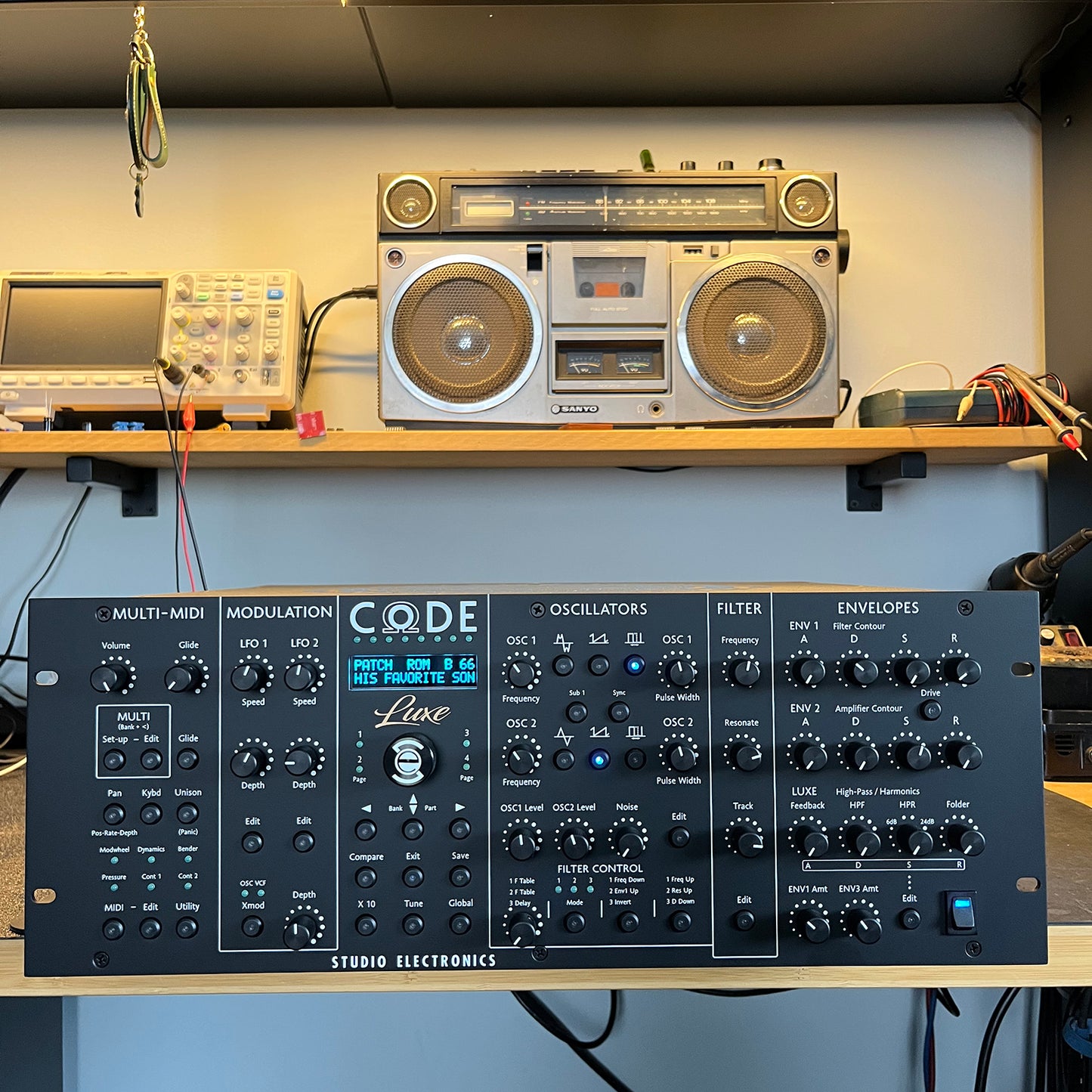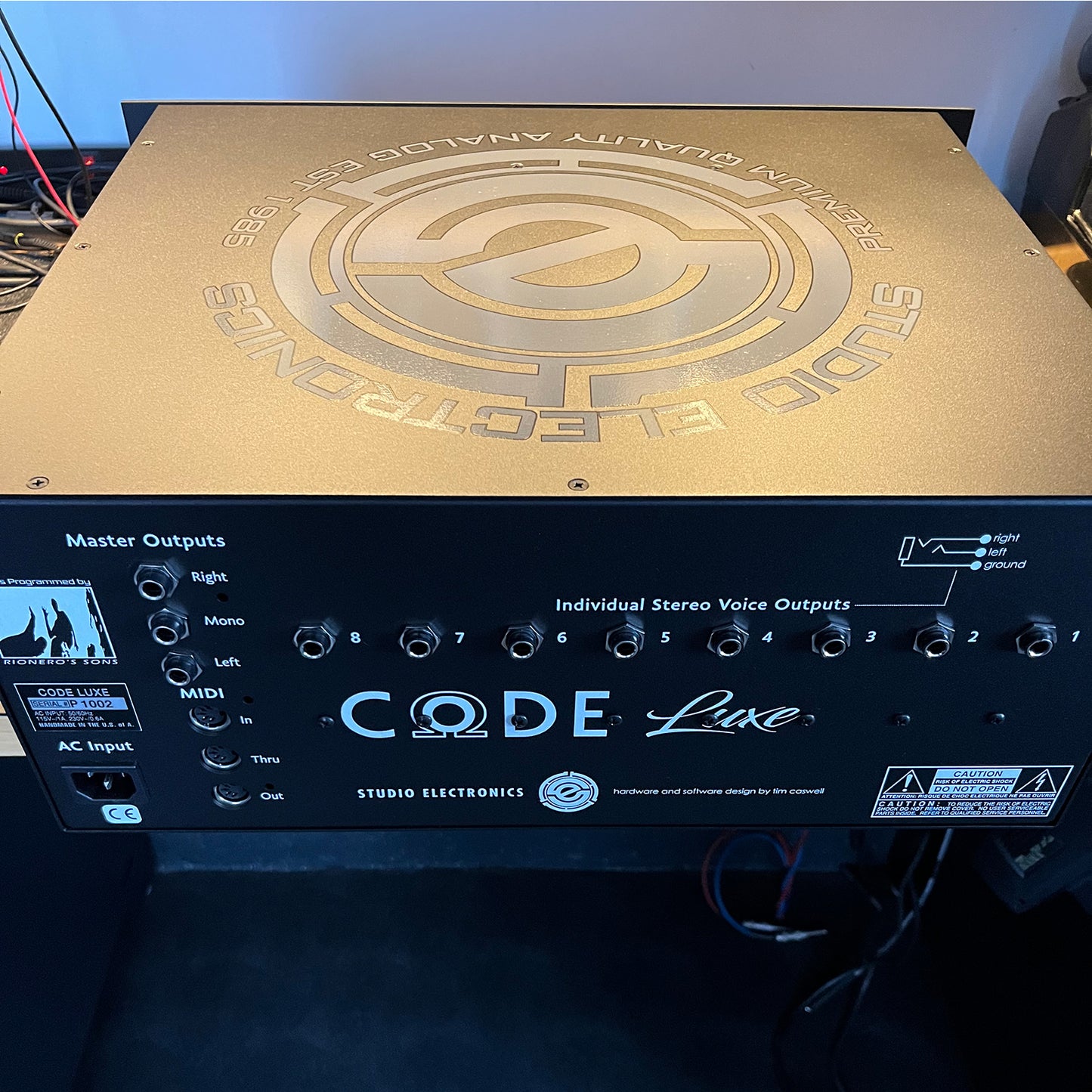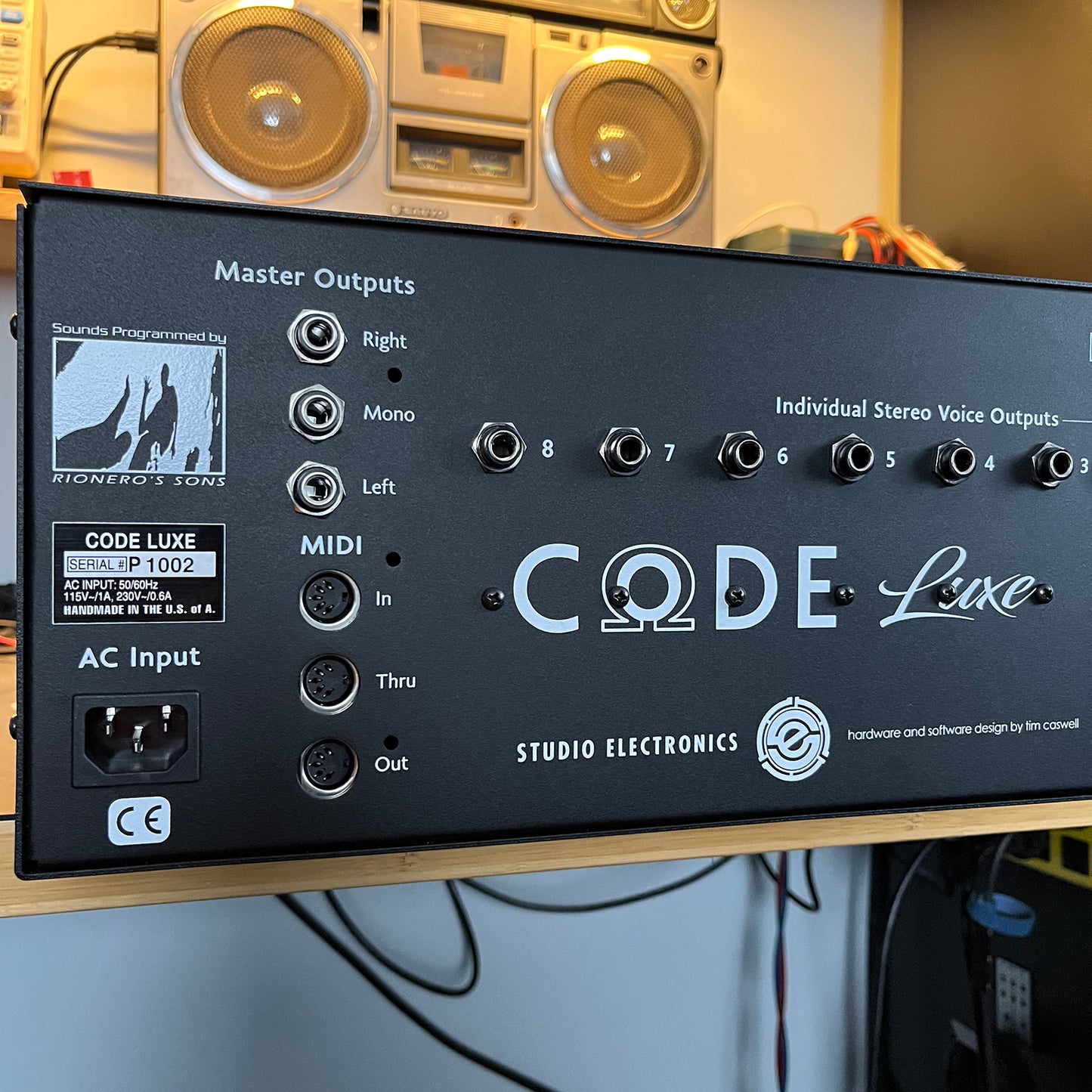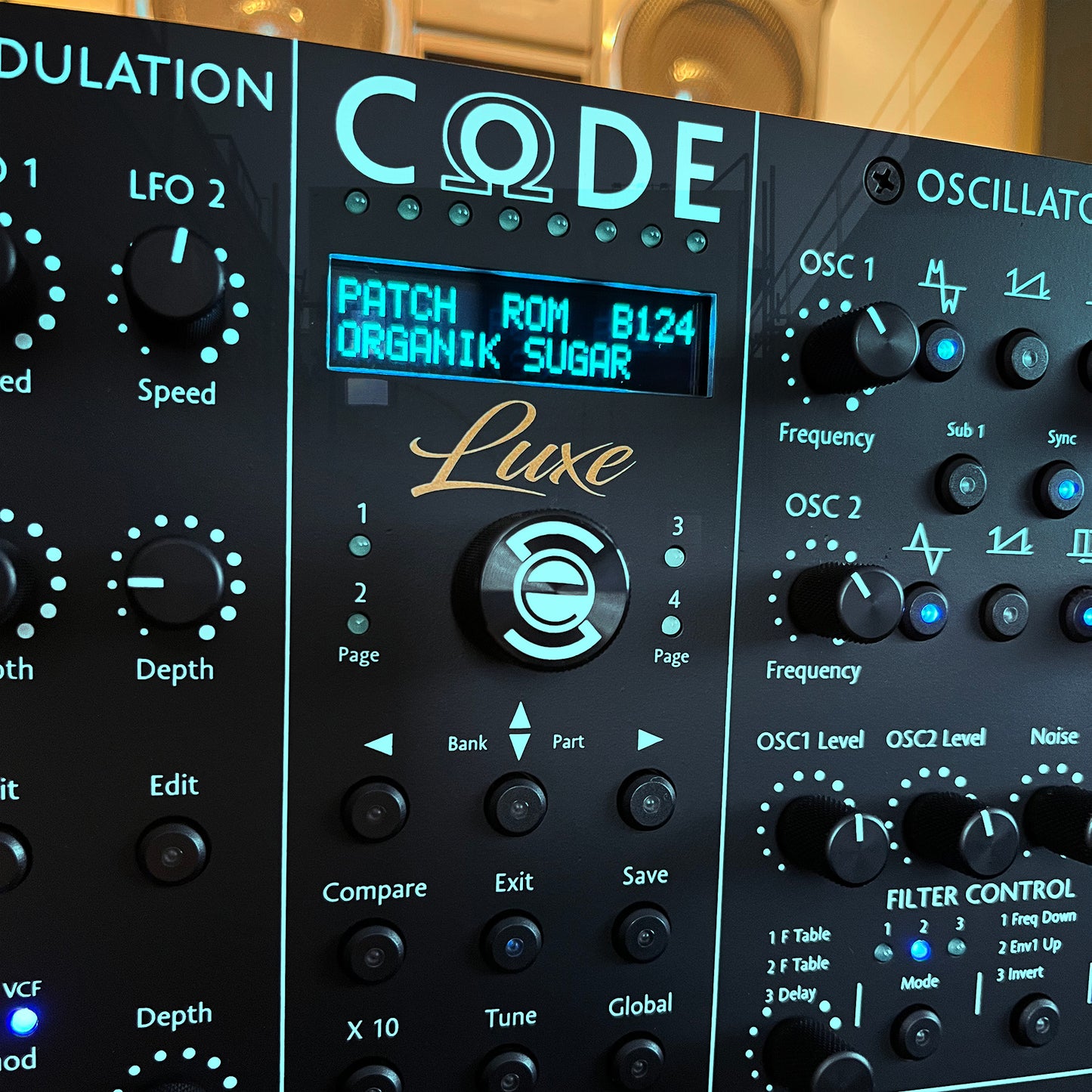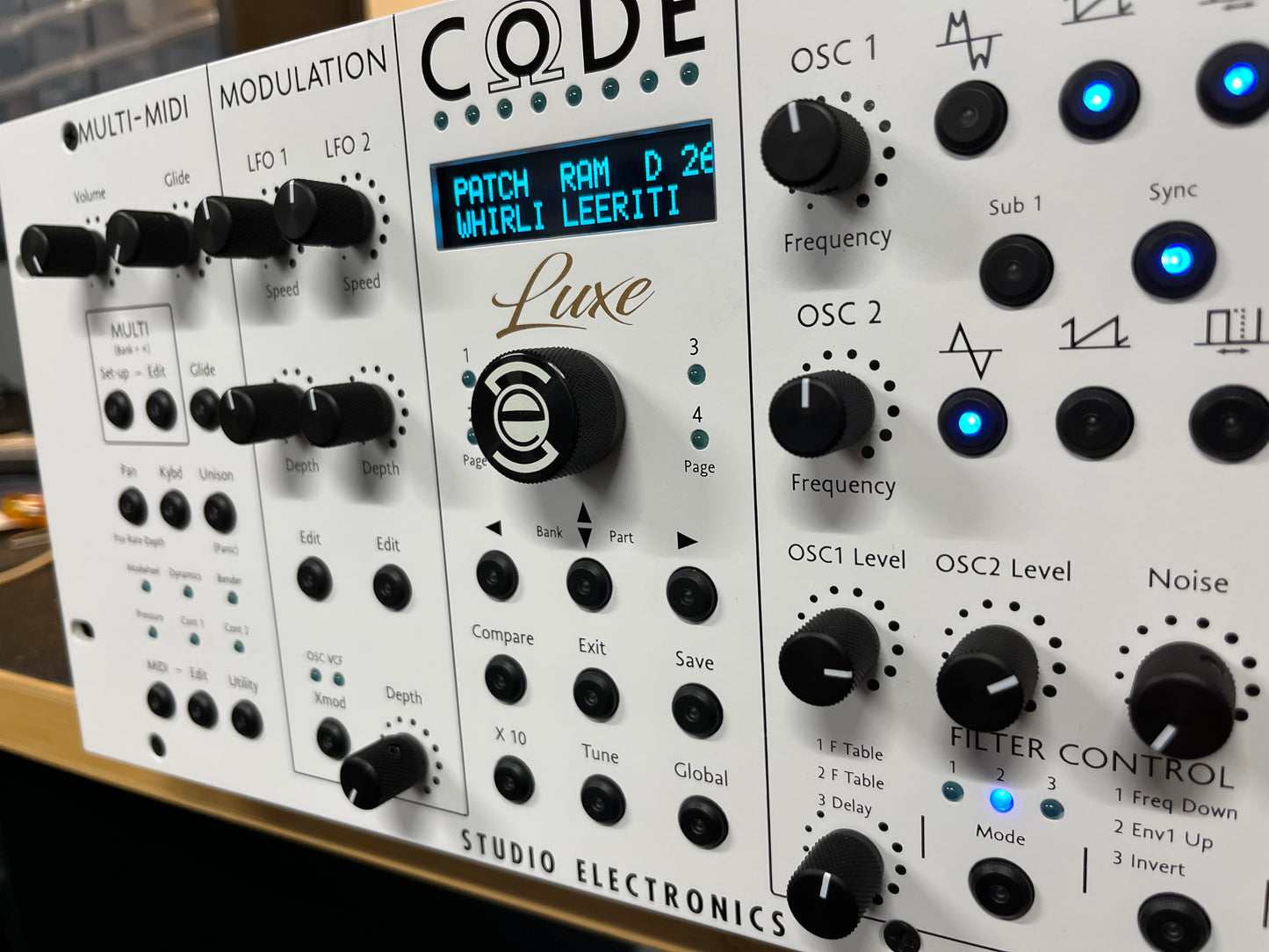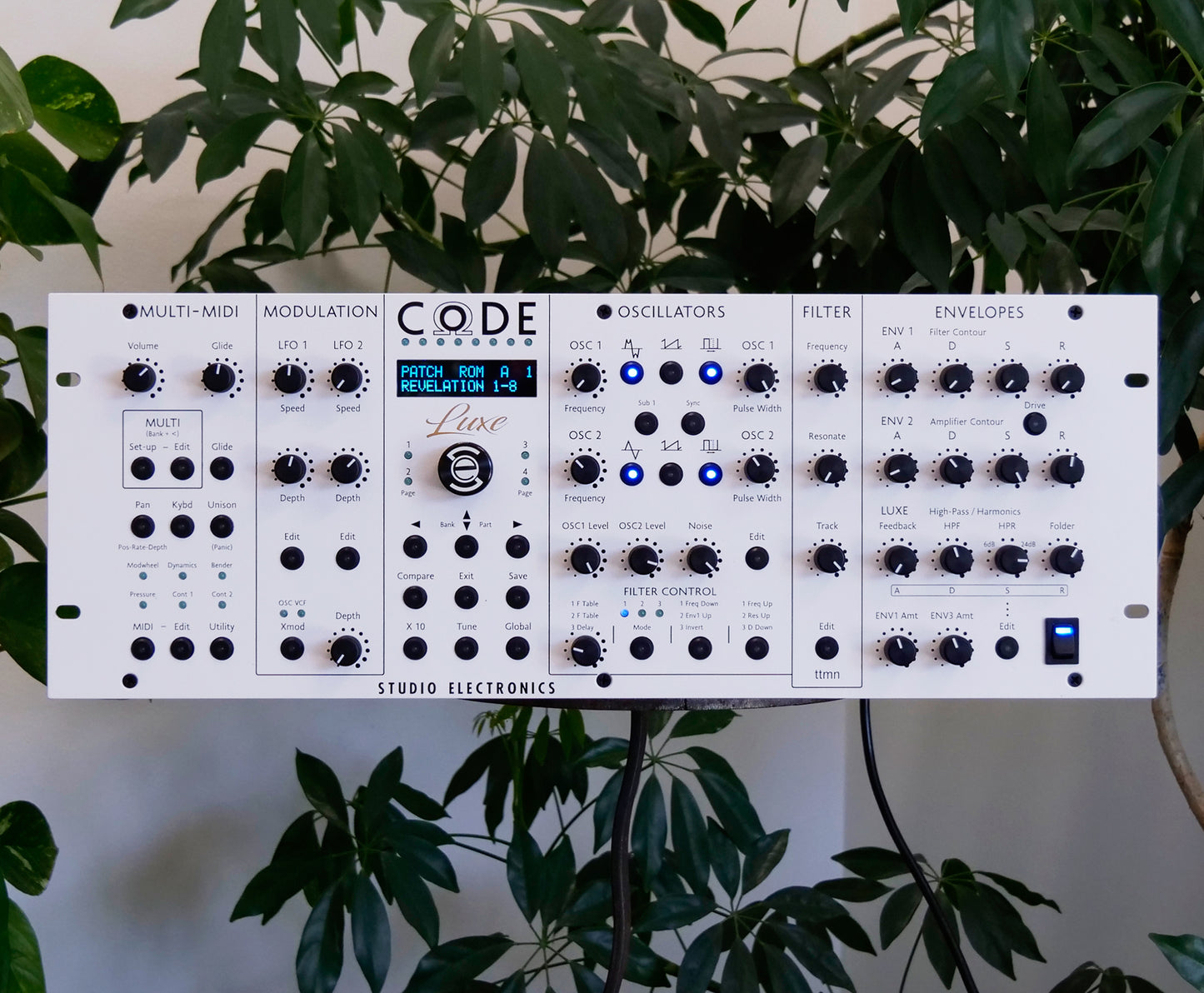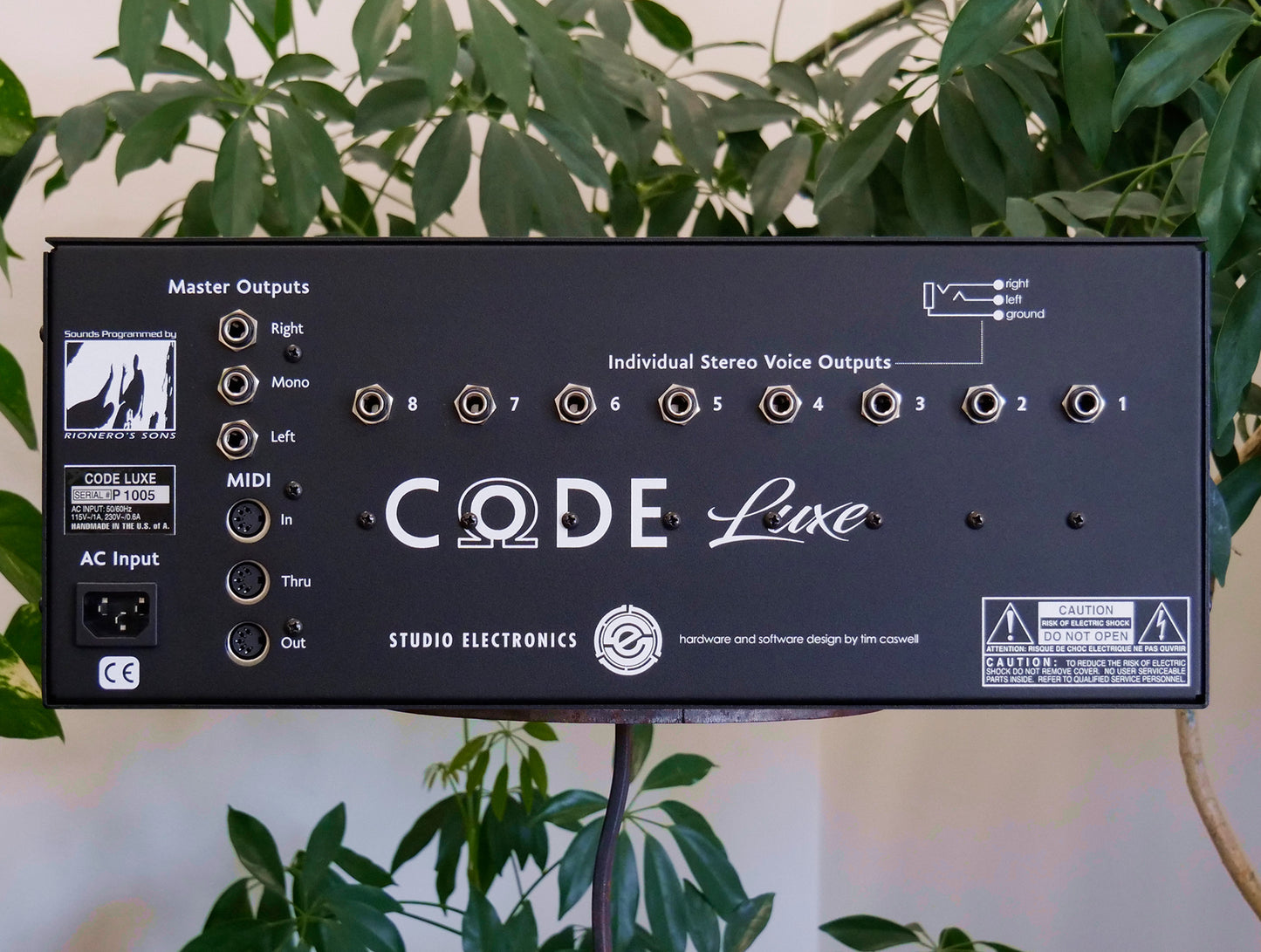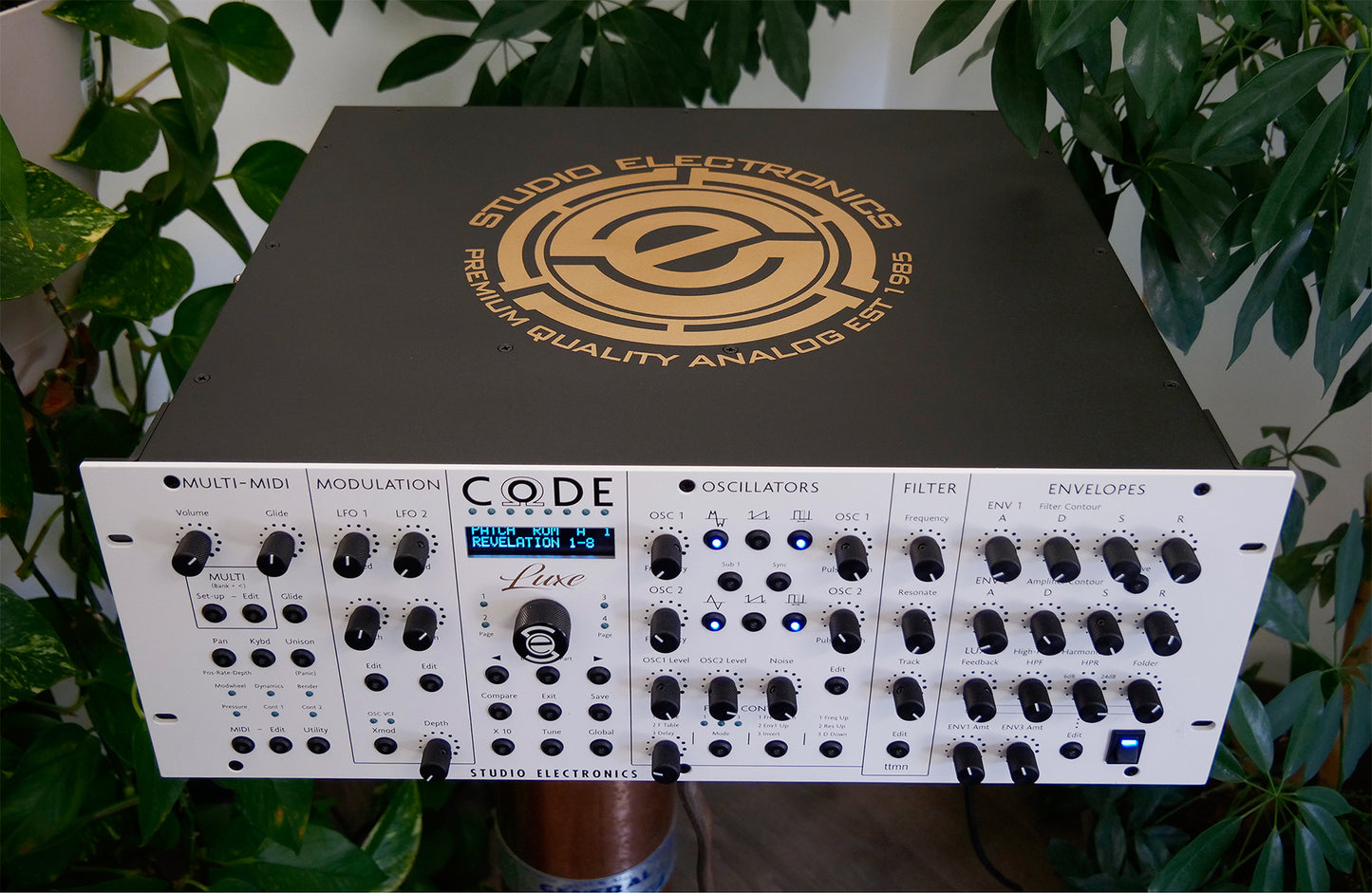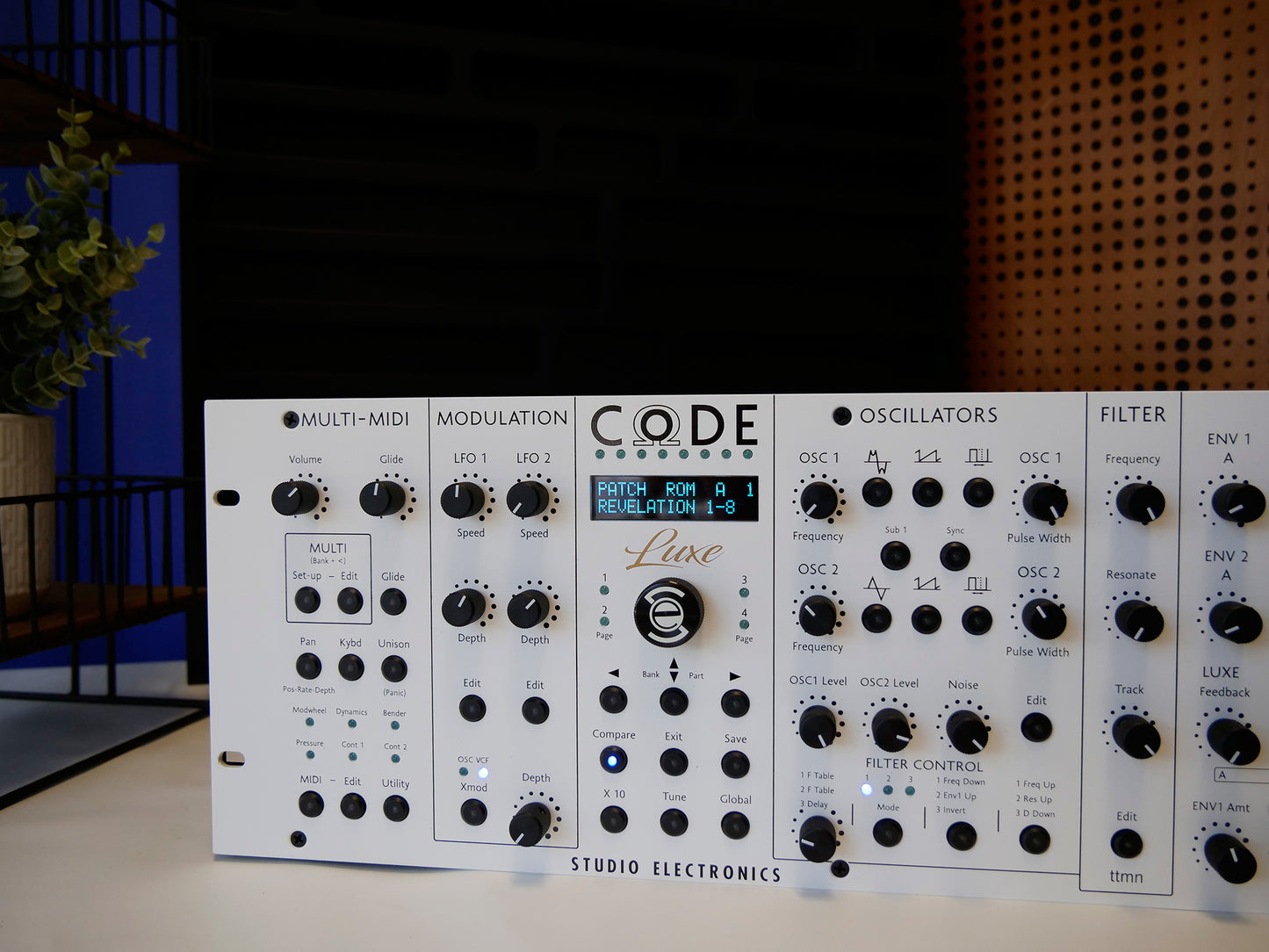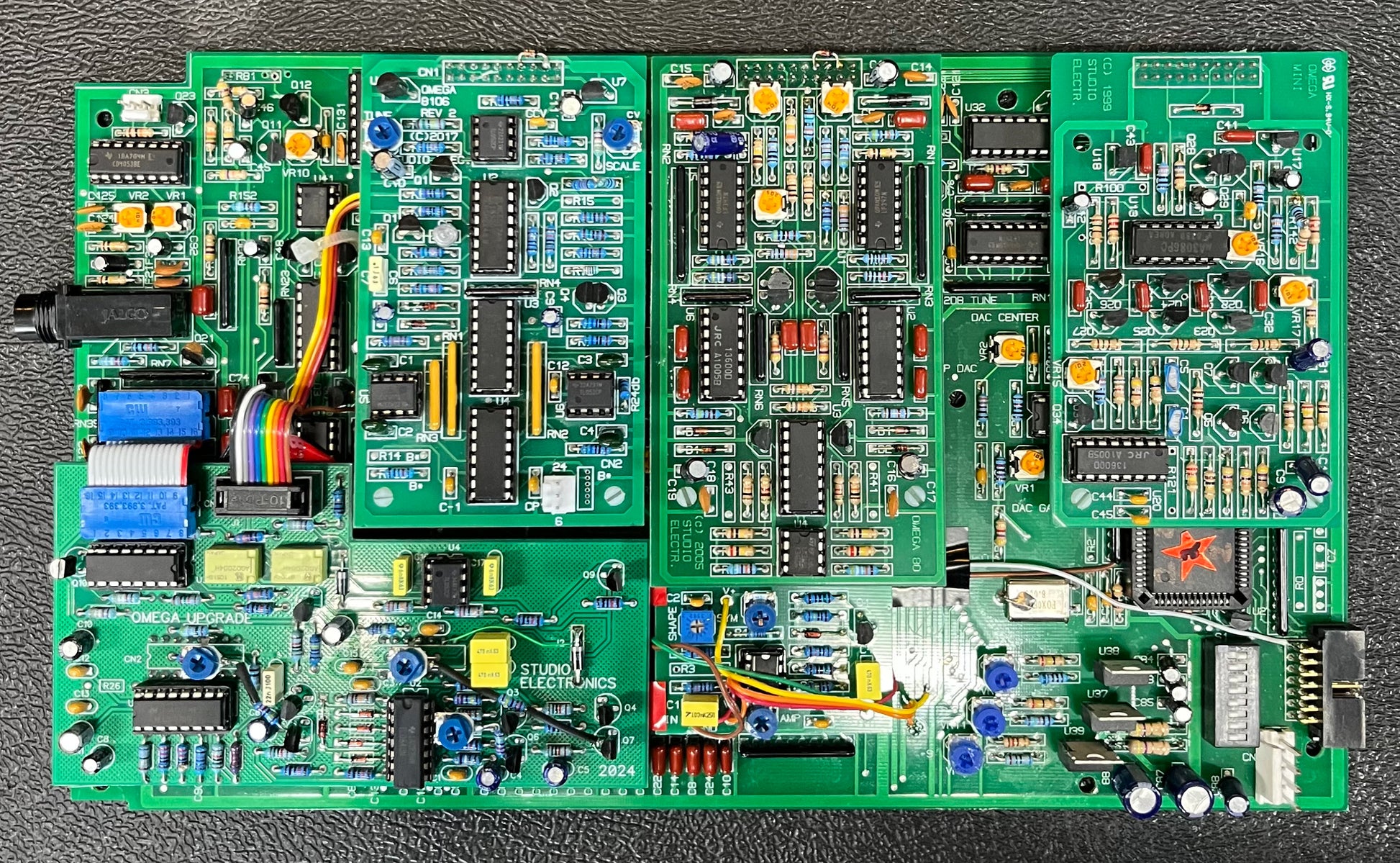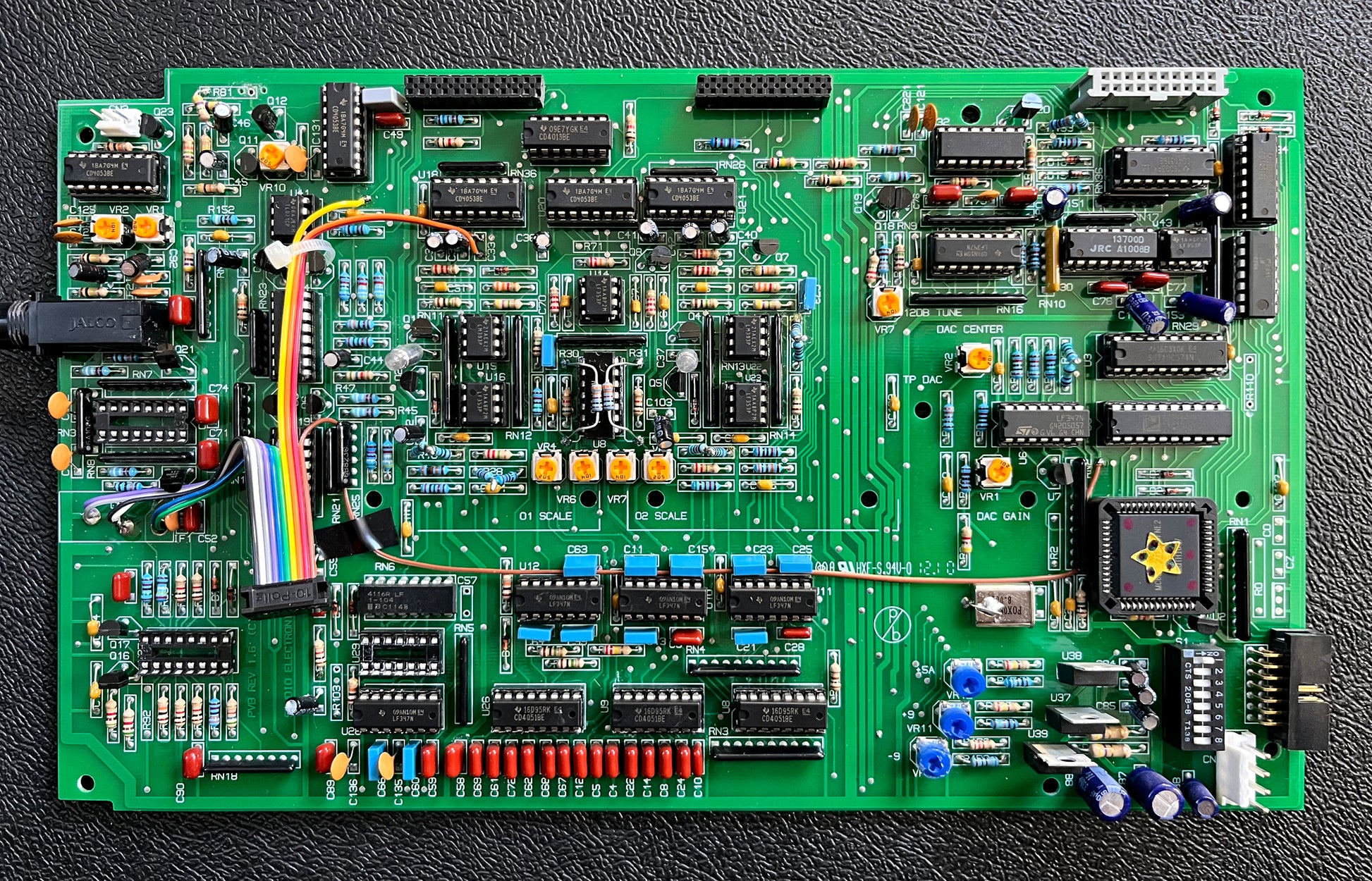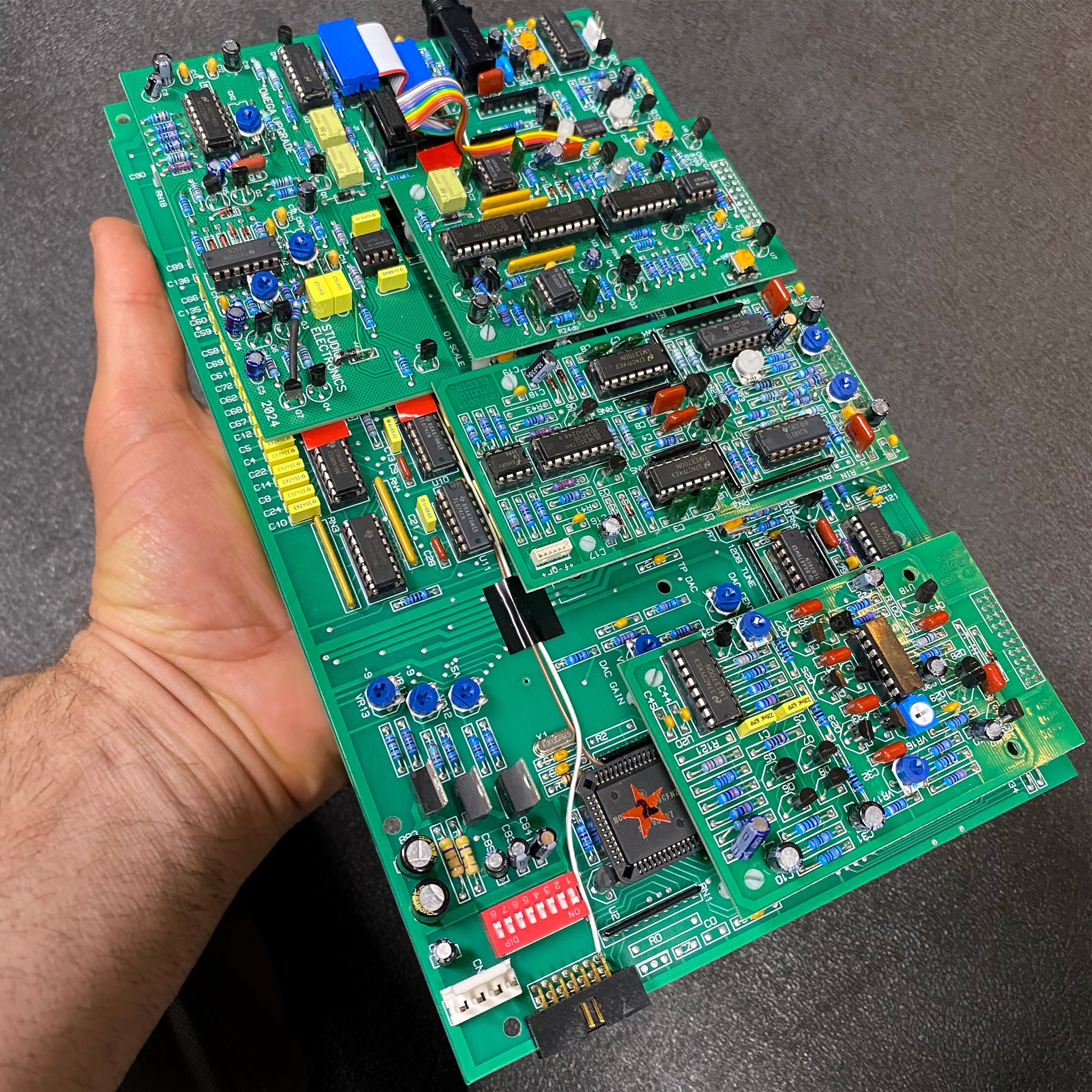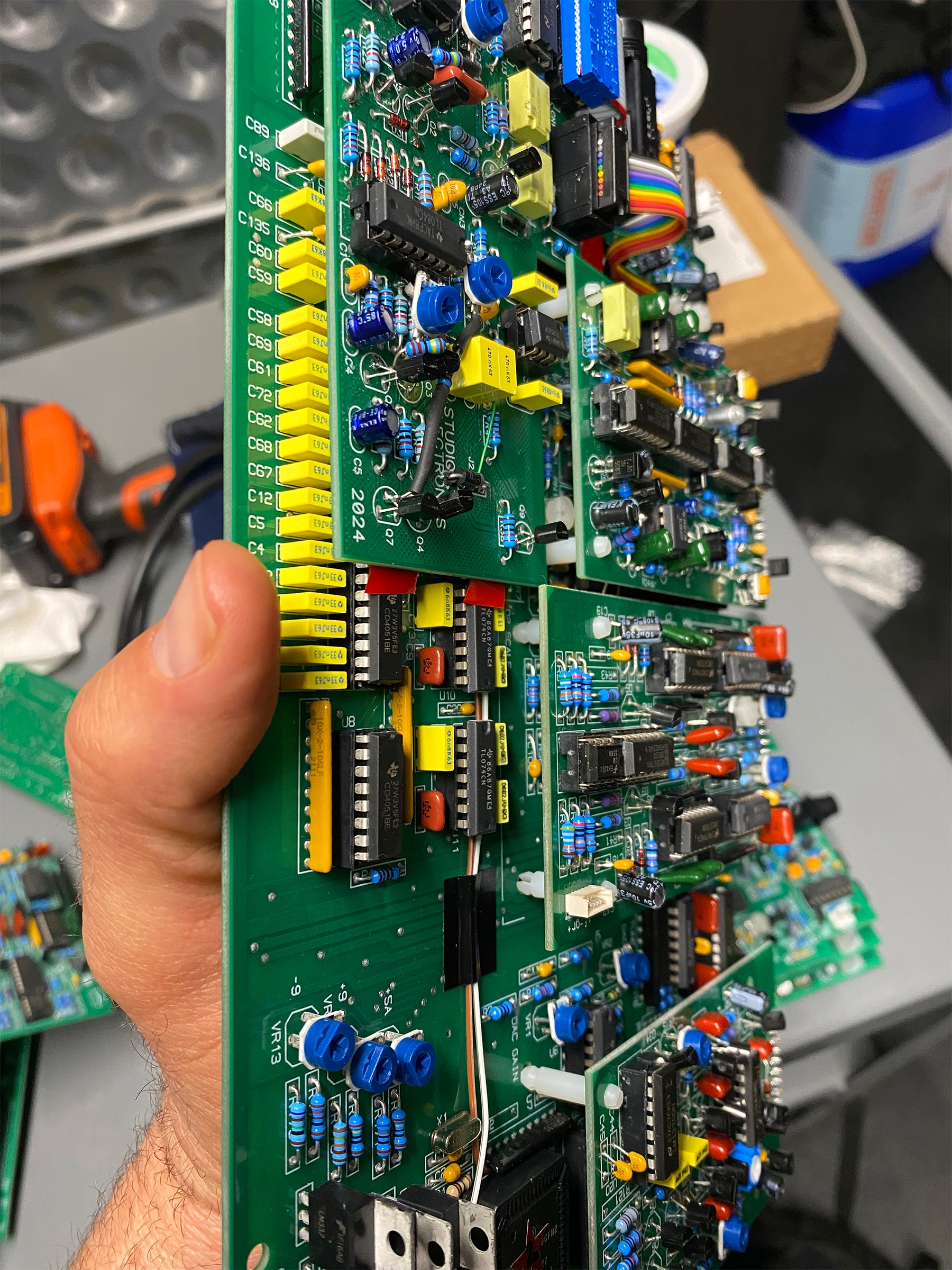studioelectronics
CODE LUXE UPGRADE (Deposit)
Couldn't load pickup availability
CODE LUXE Upgrades typically take about 5-6 weeks, due to high demand. All work is performed exclusively in our El Segundo shop.
HARDWARE FEATURES ADDED
Feedback loop
Wave-folding of oscillator 1's triangle
Programmable overdrive/AKA Fuzz
Panelized /Feedback/Hi Pass/Folder
Programmable Jupiter filter modes (if installed)
FEEDBACK
Highly dynamic audio output return to the filter input, as found on our SE-02 collaboration with Roland and SE-3X. Achieve subtle warmth and saturation, or wave squaring, theatrical desolation—especially where the CS-80 filter is concerned!—your choice.
WAVE FOLDING
The triangle output of oscillator 2 is folded before it is converted to the sine wave; the sine wave is still available when the folder is set to 0: a relay at that point redirects the output from folding to the sine wave. The folder when first engaged produces a pretty nice sine wave, but the circuit itself at that gain stage has quite a strong low grungy hum; great for adding bottom end but a bit noisy for the delicate, pretty stuff.
DRIVE
We toned down the impact of the original Fuzz circuit (renamed Drive) to make it less obviously overdriven, more musical and useful—now programmable too.
FEEDBACK/HI PASS/WAVE FOLDER
The high pass frequency and resonance controls are now panelized, along with the folding and feedback. We do this by sharing the four controls from ENV 3 (no longer labled as such): when the Envelopes Edit switch is actuated, the controls switch to ADSR controls for ENV 3.
JUPITER FILTER
Earthy 6dB and classic 24dB modes can be saved per patch.
---
SOFTWARE FEATURES ADDED
Four parameters: Wave Folding, Feedback, Hi Pass Resonance, Hi Pass Frequency, were added to the destination list of Env 3, LFO1, 2 and all the MIDI controllers.
ENVELOPES
The Envelopes got a slight but helpful speed boost. A “ticky" initial transient is available if desired.
---
PATCH BANKS
We reworked (lovingly) our A and B factory banks, modifying and bringing in sounds from other underexposed Designer Patches, adding in the feedback, folder and drive throughout, showcasing the full capabilities of the instrument’s new hardware and software features.
CALIBRATION
A full calibration is performed: Oscillators, filters, amplifiers, DACs.
PRICING
Secure your "Luxe-Up" reservation with this $750 deposit. The final payment will be determined by your unit's (sometimes unique) setup; we will provide a detailed potential cost breakdown with all options, prior to invoicing.
Omega 8s:
$2950. Includes Luxe upgrade to voice board, new front and back panels, tri to since wave conversion, discrete opamps, new patches, and calibration.
CODEs:
$2695. Includes Luxe upgrade, new front and back panel, discrete opamps, new patches, and calibration.
Set of 8 CS80 filters $995.
Set of 8 Jupiter filters $995.
OPTIONAL VISUAL SWEETENING
Kilo aluminum knobs, including large main logo knob: $395.
Daking 1900H knobs: $150 - includes large main aluminum logo knob.
OLED display: $125.
New blue switch front panel with OLED display: $795.
SHIPPING
We will calculate shipping/options prior to return shipment to customer.
Please feel free to communicate either by phone or email if questions remain!
Note: If your CODE is the original “Enigma” version with green switches, that pcb can be repurposed, reducing “Visual Sweetening” costs.
PICS
Pic 1 is the completed version (with additional filters in slots 2 and 3). Pic 2 shows the work we do to the voice board (with additional filters in slots 2 and 3); minor work is performed to the cpu and front panel pcb as well. The four CVs are repurposed from the eliminated External Input circuit for the Luxe additions.
THE EFFORT
We toiled many hours to perfect the functionality and remove some previous unheard noises coming from the CPU, discovered after 4 years in use that the OLED displays insert a considerable amount of buzzing hash into the audio path (a well-known problem with OLEDs and switching power supplies). Prior to some circuit bending mitigation, the noise sat around -30dB, now we have it at -70dB. Acceptable. Considering no one noticed it so far—not a big deal—but still important to mitigate if possible. The original LCDs added no noise.
A deposit of $750 is required to secure your place in the production schedule. There are only so many of these we can do at a time and slots will fill up quickly.
We are extremely pleased with this upgrade. It was quite the undertaking to plan and execute, not to mention the near black hole of final debugging for 4 weeks. The sonic results are immensely satisfying. Feedback has many uses to add beef, and if wanted, warm to crunchy to screaming harmonics. The folder when used alone is wonderfully rich and complex and quite metallic in some settings; with other waveforms it acts like an aural exciter, with pleasant additions in the low, mid and high frequencies.
We’re not sure if anybody has incorporated a folding circuit in a true discrete analog poly before. The programmability of the drive and the Jupiter filter modes are super handy as well.
We greatly appreciate your solid support over the years and look forward to “Luxing-Up” your CODE!
Cheers,
Greg St. Regis
---
Hear/See: YouTube SoundCloud Instagram
White and Black front panels available.
Custom front panel art available upon request.
Share
